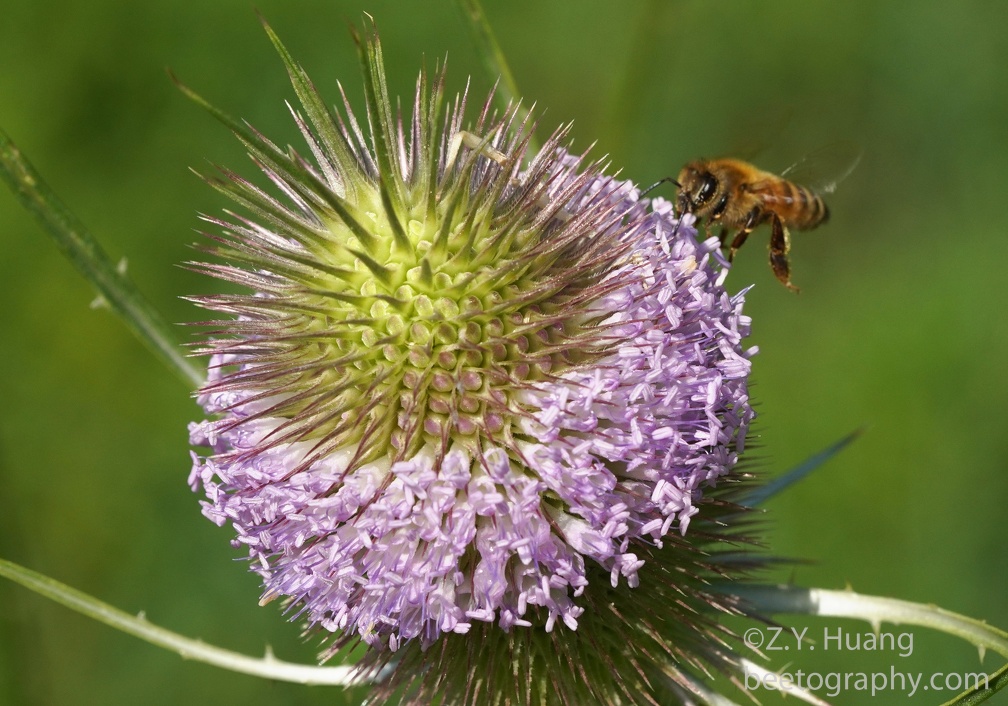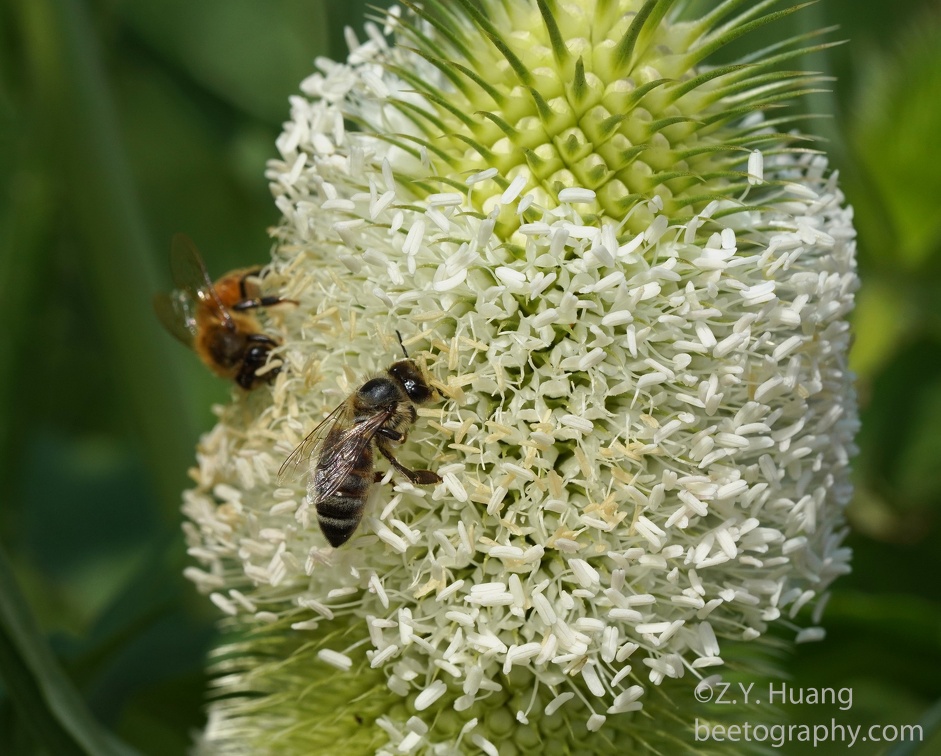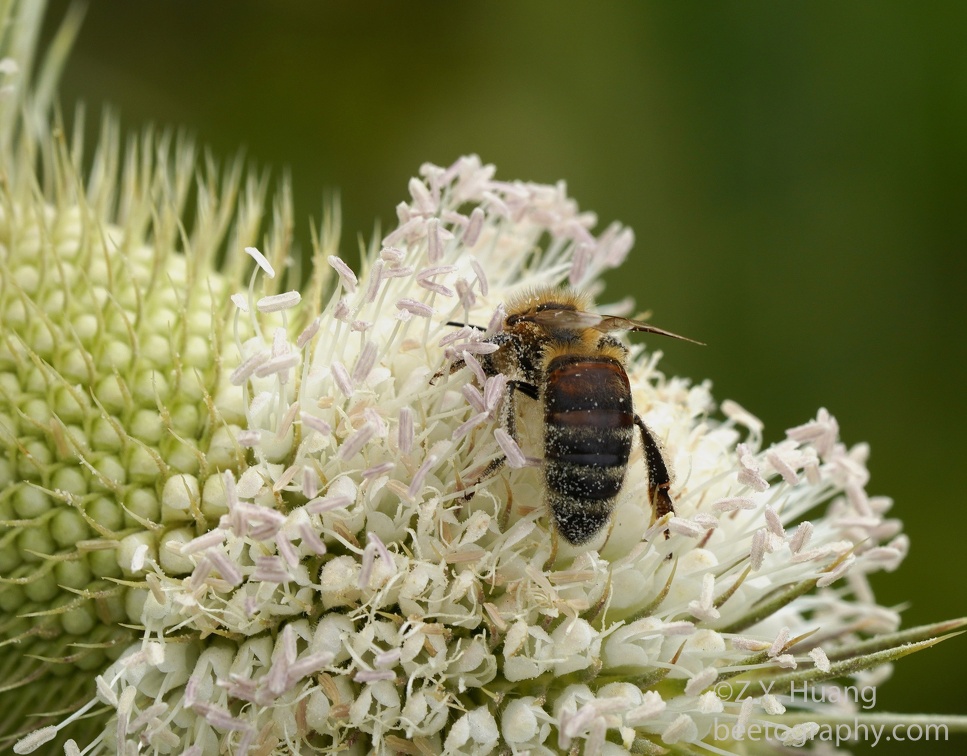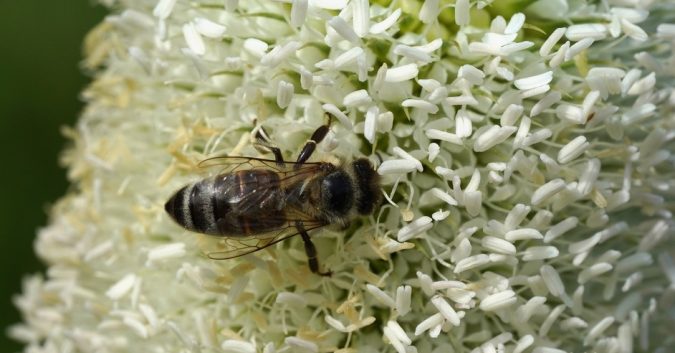| Family: | Caprifoliaceae |
| Genus: | Dipsacus |
| Species: | D. fullonum, D. laciniatus |
| Common names: | Wild teasel, cut-leaf teasel |
| ZBAS | 7 (0 to 10) Zach’s bee attraction score |
So every month we have a “Michigan Beekeeping Office Hours” zoom meeting, with about 90 people attending each time. I am responsible to talk about what is blooming in each month. I realized the teasels were blooming and I found a small patch (about 10 bundles) about 15 min away walking distance from my house. I realized I did not have photo of bees on this flower (not searchable on my computer anyway…some of my old photos were not indexed with names so I know I had some photos of flower-bees, such as small-leaf plantain, quince, but so far I could not find them!). so I walked there a few different days, morning or evening…no luck. I decided that the patch was too small and I needed to find more flowers together, perhaps easier to find honey bees working on them.
Then last Sunday I had to drive about 30 min south to near Onondago. On my way back I saw a large patch of teasels and stopped my car at a ramp (perhaps not a good idea?) and started waiting for bees and did find them foraging on this plant. Then I found many more patches on the side of 127 N. I found much larger patches near Costco Okemos and with many more bees, on the white flowers. I took more photos and was thinking I might get ticks on me walking in such deep grasses. Sure enough, I found one walking on my t-shirt when I was gassing up at a station.
On the way back home, I found some with very pretty purple flowers and with bees too. I took some more photos, came back and realized that there were two different species in Michigan, the wild teasel and cut-leaf teasel. I had to go back to see which one is which by observing their leaves. Cut-leaves had deep cuts on their lower leaves and their flowers are mostly white, some had a purplish anthers though; while wild teasels have pretty purple petals. Plus, my purple flower bee shots only had 2 to 3 good ones and I have to reshoot them (so it is a better practice to check your photos right away, not waiting for half year by then it would be too late to reshoot).
Both species are “naturalized” in Michigan but both were considered invasive (meaning not native here and also doing too well usually forming large mono-culture patches). Honey bees do love them. Strangely the flowers have lots of pollen but I did not see one bee with pollen on their corbiculae so they most are getting nectar.
Here are the photos of both species. The purple flowered ones are the wild teasel (Dipsacus fullonum), actually not as common near central Michigan. The more defining features are the lower leaves have no cuts and are long, oval shaped.
1. A honey bee foraging on wild teasel. Okemos, MI. July 14th, 2024 2. A honey bee in flight to wild teasel. This is taken the next day.
2. A honey bee in flight to wild teasel. This is taken the next day. 3. A close up of a bee probing florets on a wild teasel flower.
3. A close up of a bee probing florets on a wild teasel flower. 
Many more photos at https://ww3.beetography.com/index.php?/category/404
Now the other species, the cut-leaf teasel, Dipsacus laciniatus. Its lower leaves have deep cuts and flowers could be either color but I saw mostly white flowers. It forms larger patches than the wild teasel, also more bees.
4. A honey bee foraging on cut-leaf teasel. This one has pure white flowers.

5. Two honey bees foraging on cut-leaf teasel.

6. This flower has a slight purplish tint but mostly on the anthers only, the petals are white.

For more photos of cut-leaf flowers and bees, please visit https://ww3.beetography.com/index.php?/category/405


I am hating the newer wordpress now….so difficult to make a post linking to even uploaded images! in the old days I can use my own html codes. it should be easier, right? with newer editions? no, they make it more difficult to edit anything…Zach